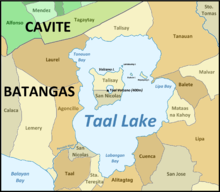Pansipit River
[1] The river stretches some 9 kilometers (5.6 mi) passing along the municipalities of Agoncillo, Lemery, San Nicolas, and Taal, serving as a boundary between the communities.
[6] In 1754, after the culmination of worst eruption of Taal Volcano had subsided, the mouth of the river was found blocked by volcanic material, eventually raising the level of the lake.
One specific strain, the lake's freshwater population of the jack Caranx ignobilis, is known to conduct its annual migration runs through the river.
[8] At one time, more than 80 different species of fish were found to inhabit the river's waters, either as a migratory channel or as a permanent residence.
[9][10] Being the sole outflow of a commercially important lake, the Pansipit has a rich history of management and regulation of its aquatic resources.
[11] During the Japanese occupation of the Philippines in World War II, the exclusive rights to the river for aquaculture purposes were leased to Santiago Banaag.
[13] Over the years, numerous measures have been attempted to curb the growing number of illegal fish cages in the river.
Some of the reasons cited referred to pollution of the river caused by effluent waste from the fish pens.
